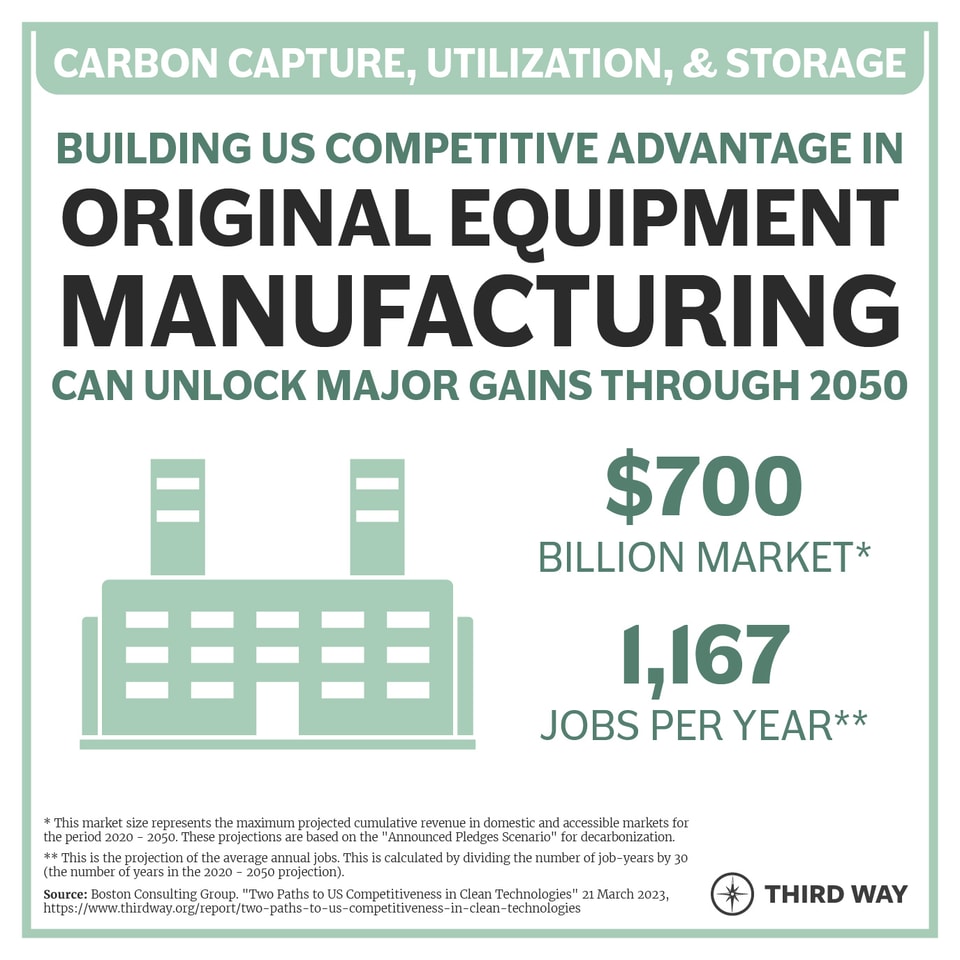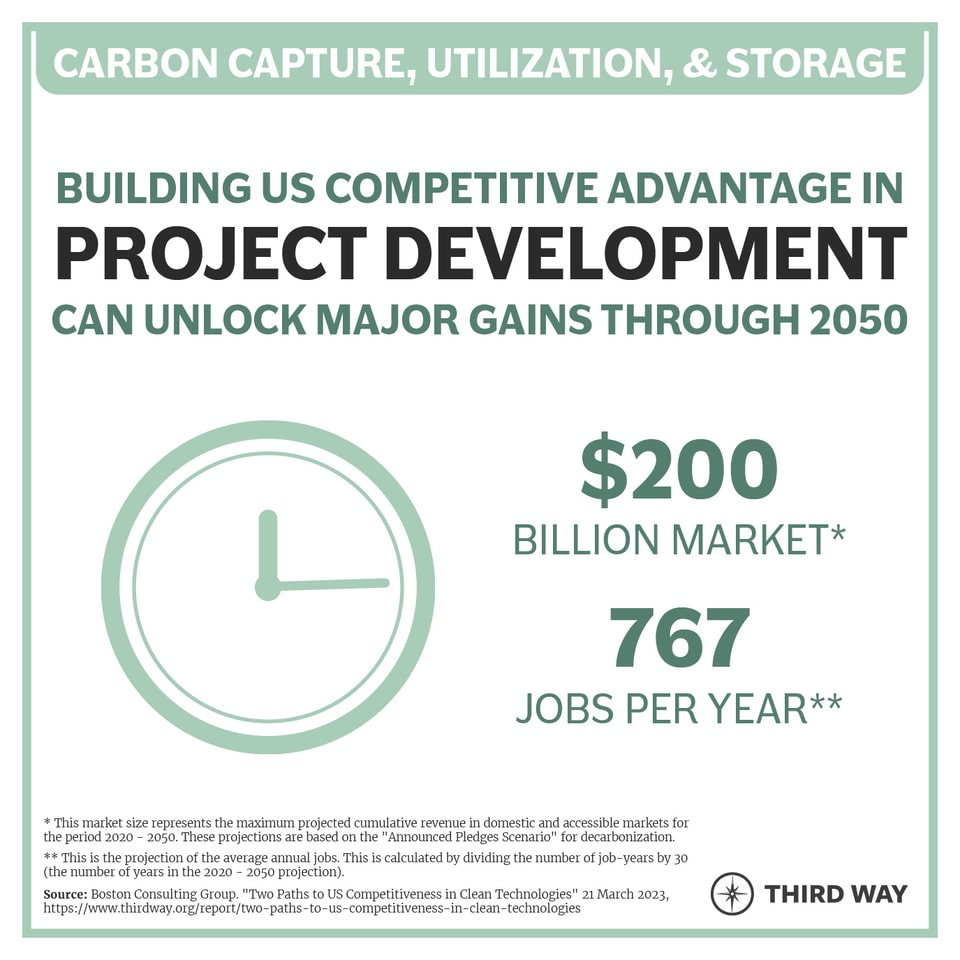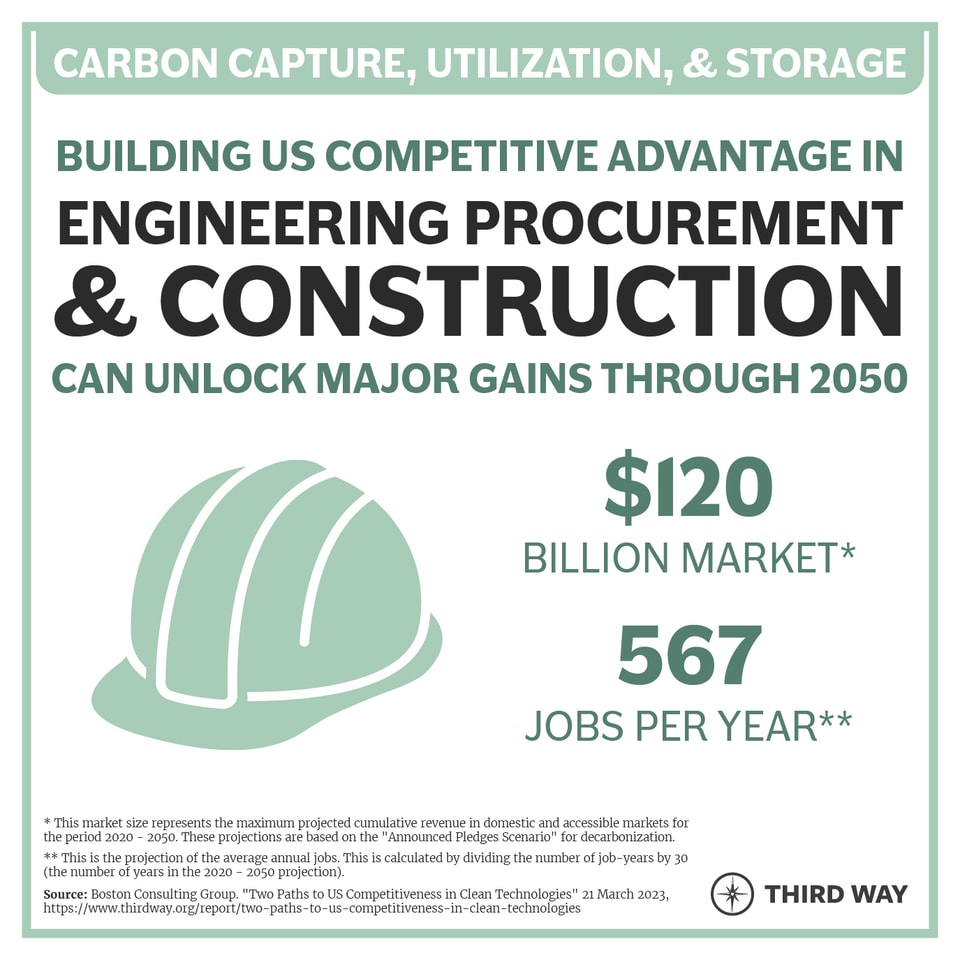Memo Published July 23, 2024 · 10 minute read
Status Report: US Leadership in CCUS Technology
Mary Sagatelova & Ryan Fitzpatrick

Carbon capture utilization and storage (CCUS) technologies are essential for achieving net-zero emissions by 2050. By deploying CCUS at both new and existing facilities, the US can cut emissions from power plants and hard-to-decarbonize heavy industries like steel, cement, and chemical manufacturing.
The United States is currently the global leader in CCUS, accounting for 60% of global carbon capture capacity and for half of planned capacity. Coupled with recent federal investments that expand carbon capture development and deployment, the US is on track to seize a significant share of a global market estimated to be worth up to $1.7 trillion and create hundreds of thousands jobs through 2050.
But global competition in CCUS markets is heating up. Countries in Asia and Europe are rapidly expanding their CCUS capabilities and, if left unchecked, will overtake America's market dominance within the next decade. By doubling down and leveraging our existing advantages, we can continue to innovate, lead, and set the global standard for CCUS technologies.
This memo spotlights key federal policies that are helping the US maintain its edge in the CCUS industry and shows how America is solidifying its’ position as the leader in global CCUS markets.
How Federal Investments are Boosting America's CCUS Industry
Landmark provisions across the Bipartisan Infrastructure Law (BIL), the CHIPS and Science Act, and the Inflation Reduction Act (IRA) are breathing new life into America’s CCUS industry, making it easier to manufacture, deploy, and export CCUS technologies at a larger scale. These incentives, which will be distributed over the course of several years, are giving the private sector confidence to support and invest boldly in innovative CCUS technologies. Some of the most impactful federal incentives include:
- $3.22 billion in production tax credits to lower the cost of carbon capture and sequestration technologies and accelerate deployment;
- $6.5 billion in funding to support large-scale pilot carbon capture projects, procurement of products derived from captured carbon, permitting for geological sequestration, and front-end engineering and design for carbon transport infrastructure;
- $10 billion to manufacturing tax credits to incentivize existing facilities to retool for cleaner manufacturing and to produce clean energy equipment and components—both of which could apply to CCUS; and
- New initiatives that boost carbon sequestration R&D, authorize using the outer continental shelf for long-term carbon sequestration, and support research to advance geological carbon storage.
These federal investments will be distributed over the next decade and will continue to pay dividends long after. And based on our analysis of Rhodium Group and MIT CEEPR’s Clean Investment Monitor, it’s clear that these policies are already working. Public and private investment in CCUS technologies in just the past three years has reach over $5 billion.
Road to Victory: Building on US Leadership in CCUS Technologies

Competition in clean energy markets—especially for carbon capture technologies—is intense and will only increase as large economies with significant industrial capacities turn to carbon management to meet decarbonization needs. The US is currently in the lead, but with other countries rapidly catching up, we can’t afford to rest on our laurels.
Dominating global CCUS markets will have an enormous pay-off and is well worth the effort, but the alternative is far worse. Failing to maintain our leadership would not just mean missing out on significant economic gains, but rather, it allows other countries to set global standards for carbon measurement, monitoring, reporting, and verification without us—undermining American technical leadership and influence on the world stage.
By capitalizing on our existing advantages, we can build on the successes we’ve already amassed and secure our leadership in the global carbon capture ecosystem. Third Way’s landmark analysis, in partnership with Breakthrough Energy and Boston Consulting Group, found that there are 3 segments of the CCUS supply chain where the US should make the most effort to build or maintain its advantage. These segments were identified based on their market size and the potential for American leadership—and we’re already seeing significant progress in these key areas. Let’s break this down:
Original Equipment Manufacturing (OEM)
Manufacturing the chemical solvents, sorbents, and equipment needed to capture carbon dioxide from exhaust gas is currently expensive and energy intensive. Right now, no single country dominates this segment, leaving a global market worth up to $700 billion up for grabs. The US, with our robust research ecosystems and leadership in CCUS patents and publications, has a distinct advantage and is well-positioned to capture a sizeable share of this market and create over 1,000 jobs every year through 2050. And we’re already racking in big wins:
- Generating Value-Add Products: The Department of Energy is investing $17.5 million to support projects that advance carbon capture technologies from point-sources and converting those emissions into valuable products like asphalt, fertilizer, and chemicals. This funding is laying the groundwork for a strong domestic carbon conversion industry by deepening partnerships between the federal government, universities, and project developers, and is reinforcing American leadership in innovative carbon utilization. developers, and is reinforcing American leadership in innovative carbon utilization.
- Advancing Carbon Capture Innovation: The Department of Energy is investing $45.6 million in nine projects that are advancing carbon capture technology for industrial facilities and power plants. These investments are establishing a foundation for American leadership in carbon capture innovation, particularly in regions with historic ties to oil and gas, and are letting the US set global standards for carbon capture technology.
- Setting a Standard for Meaningful Engagement: The Department of Energy is investing $304 million in four large-scale carbon capture projects that are engaging in early, frequent, and meaningful engagement in local communities, ensuring that the benefits of carbon capture projects are well understood and embraced. By prioritizing community involvement, the US is showcasing a model for meaningful development.

Project Development
CCUS projects are complex, requiring management across the entire value chain, including permitting, contracting, engineering, securing financing, transport, and storage, and often coordinating with multiple stakeholders. Currently, there is no established business model for project developers, presenting an opportunity for US firms to set the global standard and capture a large portion of a global market worth up to $200 billion while creating over 700 US jobs every year through 2050. Leveraging their experience managing complex oil and gas projects and expertise in subsurface management for carbon storage, American firms are uniquely positioned to be first movers and set the benchmark for the industry. Here’s how we’re already building our track record:
- Managing Complex Projects: Air Products is investing $4.5 billion in a blue hydrogen production facility in Louisiana—producing 750 million standard cubic feet of hydrogen and storing 5 million metric tons of carbon a year—making it the largest carbon capture and storage project in the world. Air Products’ facility showcases US leadership in managing and developing projects across multiple energy types and complex technologies, reinforcing our role as a leader in CCUS.
- Putting Communities First: The Department of Energy is investing $890 million in three large-scale CCUS projects that are demonstrating first-of-a-kind technological ecosystems involving diverse stakeholders and community-driven project implementation. This is the first round of selected projects, with more expected in the near future. By supporting innovative and collaborative CCUS projects, the US is setting a global standard for technological ecosystems and stakeholder engagement.
- Showcasing Vertically Integrated Solutions: Carbon America is financing, building, and operating carbon capture and sequestration technologies across two ethanol production facilities in Colorado, aiming to capture and store 95% of the carbon emissions per year. As the world’s first vertically integrated CCUS super developer, Carbon America’s project is showcasing American leadership in complex project development and execution, and underscoring our capability to simultaneously manage complex financing, technology, and operation.

Engineering, Procurement, and Construction
System quality and reliability are crucial for minimizing risk of adding CCUS to high-value assets like refineries, industrial facilities, and power plants. US Engineering, Procurement, and Construction (EPC) firms, with their strong technical expertise and proven track record in addressing safety concerns, hold a competitive advantage. They have the opportunity to export this expertise to countries launching their first CCUS projects—seizing a large portion of a $120 billion global market and creating over 500 US jobs every year through 2050 in the process.
- Building Career Pathways: The National Energy Technology Laboratory (NETL) is facilitating seven regional technology training centers to promote CCUS knowledge sharing and expanding project-based training opportunities. NETL’s training programs are creating pathways for transitioning legacy oil and gas workers to new careers and showcasing how academic and research institutions can contribute to workforce development. By leading in knowledge sharing and workforce transition, the US is setting the standard for what the future of CCUS career training will look like.
- Boosting Career Readiness: The United Association of Union Plumbers and Pipefitters (UA) signed a Memorandum of Understanding (MOU) with Capture Point Solutions and the Vernon Parish School Board in Leesville, Louisiana, to establish the “Capturing Better Futures” Initiative. The program will provide carbon capture and technical career training to high school students in rural Vernon Parish, helping expand a much-needed workforce. By integrating technical training into our educational system, the US is leading the way for preparing the next generation of CCUS professionals.

Other Value Chain Segments
Broadly, the US has achieved significant progress in the CCUS industry. Here are several overarching wins worth noting:
- Sending Clear Demand Signals: The Department of Energy is leveraging $2.5 billion to support a total of six carbon capture demonstration projects, showcasing the federal government’s commitment to integrating carbon capture, transport, and storage technologies into power plants and industrial facilities. This program is not just accelerating the deployment of CCUS technology across the country, it’s sending a clear signal to the private sector that the US is serious about supporting this growing industry.
- Building Carbon Transport Capacity: The Carbon Dioxide Transportation Infrastructure Finance and Innovation (CIFIA) program is a unique financing mechanism that currently has the capability to provide $2.1 billion in flexible, low interest loans and grants, while lowering the risk of private sector investment. It was established by the BIL with further investment from the IRA and supports the buildout of a safe and reliable carbon transportation system throughout the US. By ensuring that carbon transport infrastructure is commercially developed and ready to meet today’s needs, and future CCUS facility demand, the US is building a distinct advantage in global markets.
- Data-Backed CCUS Strategies: The Rhodium Group is conducting a state-by-state analysis focusing on carbon capture retrofit and pipeline transportation workforce opportunities across the US. By identifying how CCUS technologies can be best customized to fit within different state economies and industrial landscapes, Rhodium’s data-backed approach is helping tailor CCUS deployment to meet different regional needs and demonstrating US leadership in smart technology deployment.
So, What’s Next?
The US currently leads the world in CCUS development and deployment, but other countries are rapidly building out their own CCUS industries. Moving forward, competition in CCUS markets will undoubtably be fierce, but as our analysis has shown, it’s a fight worth having.
The US has already taken significant steps to maintain our edge, by investing in innovative projects, fostering RD&D, and building a diverse and skilled workforce. By leveraging our existing advantage and continuing to invest in CCUS technologies, we can ensure the global CCUS market is US-led.


